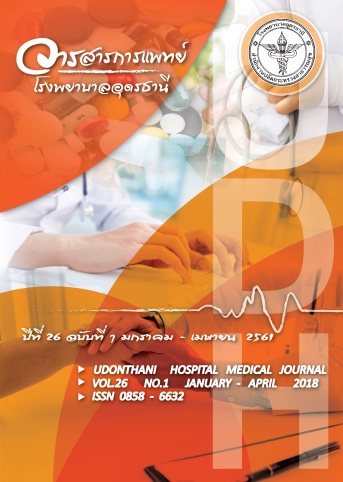ผลลบลวงของการผ่าตัดต่อมน้ำเหลืองเซนติเนลในผู้ป่วยมะเร็งเต้านมระยะเริ่มแรก ในโรงพยาบาลอุดรธานี
คำสำคัญ:
ต่อมน้ำเหลือเซนติเนล, มะเร็งเต้านม, การเลาะต่อมน้ำเหลืองรักแร้, ผลลบลวงบทคัดย่อ
มะเร็งเต้านมเป็นมะเร็งที่พบบ่อยที่สุดในสตรีไทย มีวิธีการดูแลรักษาที่ก้าวหน้าทันสมัย และได้รับการพัฒนาต่อเนื่องมาโดยตลอด ทั้งการตรวจวินิจฉัย การผ่าตัด การให้ยา และรังสีรักษา ซึ่งในปัจจุบัน ผู้ป่วยมะเร็ง เต้านมสามารถมีอัตราการอยู่รอดที่สูงขึ้น และมีคุณภาพชีวิตที่ดีขึ้น
การผ่าตัดต่อมน้ำเหลืองเซนติเนลถือเป็นการผ่าตัดมาตรฐานในการตรวจวินิจฉัยและกำหนดระยะของโรคสำหรับผู้ป่วยมะเร็งเต้านมระยะเริ่มแรก โดยเป็นการผ่าตัดเพื่อนำต่อมน้ำเหลืองที่รักแร้กลุ่มแรกที่รับการระบายน้ำเหลืองจากก้อนมะเร็งออกมาเพื่อส่งตรวจ โดยเทคนิคการผ่าตัด สามารถทำได้โดยการใช้สาร radioactive หรือ isosulfan blue หรือใช้ทั้งสองวิธีร่วมกัน ซึ่งมีอัตราการตรวจพบและผลลบลวงที่แตกต่างกันไปในแต่ละสถาบัน ผู้วิจัยจึงต้องการศึกษาถึงผลลบลวงของการผ่าตัดต่อมน้ำเหลืองเซนติเนลในผู้ป่วยมะเร็งเต้านมระยะเริ่มแรกในโรงพยาบาลอุดรธานี
ระเบียบวิธีวิจัย ทำการศึกษาและเก็บข้อมูลในผู้ป่วยมะเร็งเต้านมระยะเริ่มแรก ตั้งแต่ สิงหาคม 2558 ถึง กรกฎาคม 2560 โดยผู้ป่วยทุกรายจะได้รับการผ่าตัดต่อมน้ำเหลืองเซนติเนลโดยใช้สาร isosulfan blue และเลาะต่อมน้ำเหลืองรักแร้ระดับ 1 และ 2 เพื่อส่งตรวจทางพยาธิวิทยา ทำการวิเคราะห์ข้อมูลและแสดงผลออกมาเป็นผลลบลวง ค่าความไว ค่าความจำเพาะและค่าความแม่นยำ
ผลการศึกษาผู้ป่วยมะเร็งเต้านมระยะเริ่มแรกทั้งหมด 104 ราย ได้เข้ารับการผ่าตัดต่อมน้ำเหลืองเซนติเนล มีอายุเฉลี่ย 52 ปี ขนาดก้อนมะเร็งเฉลี่ย 2.7 เซนติเมตร และพบว่ามะเร็งชนิด invasive ductal carcinoma เป็นชนิดที่พบมากที่สุด สำหรับอัตราการตรวจพบต่อมน้ำเหลืองเซนติเนลในการศึกษานี้พบร้อยละ 100 โดยมี ค่ามัธยฐานของต่อมน้ำเหลืองเซนติเนลคือ 2 ต่อม
จากการตรวจทางพยาธิวิทยา พบการกระจายของมะเร็งในต่อมน้ำเหลืองเซนติเนล 38 ราย (ร้อยละ 36.5) ในขณะที่ผู้ป่วยอีก 66 ราย ไม่พบการกระจายของมะเร็งในต่อมน้ำเหลืองเซนติเนล แต่กลับพบว่ามีผู้ป่วย 3 รายที่พบการกระจายของมะเร็งในต่อมน้ำเหลืองรักแร้ ดังนั้น การผ่าตัดต่อมน้ำเหลืองเซนติเนลในงานวิจัยนี้ พบว่า มีผลลบลวง ร้อยละ 4.5 มีความไวร้อยละ 90.9 ความจำเพาะร้อยละ 88.7 และความแม่นยำร้อยละ 89.4
สรุปผลการวิจัยการผ่าตัดต่อมน้ำเหลืองเซนติเนลในผู้ป่วยมะเร็งเต้านมระยะเริ่มแรกในโรงพยาบาลอุดรธานีมีความแม่นยำในการบ่งชี้การกระจายของมะเร็งไปยังต่อมน้ำเหลืองรักแร้โดยมีค่าผลลบลวงร้อยละ 4.5
เอกสารอ้างอิง
2. Giuliano AE, Hunt KK, Ballman KV, Beitsch PD, Whitworth PW, Blumencranz PW, et al. Axillary dissection VS no axillary dissection in women with invasive breast cancer and sentinel node metastasis:a randomized clinical trial. JAMA. 2011;305:569-575.
3. Bergmann A, Mendes VV, de Almeida Dias R, do Amaral ESB, da Costa Leite Ferreira MG, Fabro EA. Incidence and risk factors for axillary web syndrome after breast cancer surgery. Breast cancer research and treatment. 2012;131(3):987-92.
4. De Gournay E, Guyomard A, Coutant C, Boulet S, Arveux P, Causeret S, et al. Impact of sentinel node biopsy on long-termquality of life in breast cancer patients. British journal of cancer. 2013;109(11):2783-91
5. Disipio T, Rye S, Newman B, Hayes S. Incidence of unilateral arm lymphoedema after breast cancer: a systematic review and meta-analysis. The Lancet Oncology. 2013;14 (6):500-15.
6. Krag DN, Weaver D, Ashikaga T, Moffat F, Klimberg VS, Shriver C, et al. The sentinel node in breast cancer-a multicenter validation study. N Engl J Med 1998;339:941-6.
7. Moghimi M, Ghoddosi l, Rahimabadi AE, Sheikhvatan M. Accuracy of sentinel node biopsy in breast cancer patients with a high prevalence of axillary metastases. Scandinavian Journal of Surgery. 2009;98(1):30-33. 8. Monleon S, Murta-Nascimento C, Bascuas I, Macia F, Duarte E, Belmonte R. Lymphedema Predictor Factors after Breast Cancer Surgery : A Survival Analysis. Lymphatic research and biology.2015;13(4):260-7.
9. Acuna SA, Angarita FA, Escallon J. Assessing patterns of practice of sentinel lymph node biopsy for breast cancer in Latin America. World journal of surgery. 2014;38(5): 1077-83.
10. Canavese G, Gipponi M, Catturich A, Di Somma C, Vecchio C, Rosato F, et al. Sentinel lymph node mapping in early-stage breast cancer: technical issues and results with vital blue dye mapping and radioguided surgery. Journal of surgical oncology. 2000;74(1): 61-8.
11. Cody HS III. Clinical aspects of sentinel node biopsy. Breast cancer research : BCR. 2001;3(2):104-8. 12. Gipponi M, Bassetti C, Canavese G, Catturich A, Di Somma C, Vecchio C, etal. Sentinel lymph node as a new marker for therapeutic planning in breast cancer patients. Journal of surgical oncology. 2004;85(3):102-11.
13. Giuliano AE, Kirgan DM, Guenther JM, Morton DL. Lymphatic mapping and sentinel lymp had enectomy for breast cancer. Annals of Surgery. 1994;220:391-398.
14. Kantaraksa N, Kongdan Y, Suvika pakornkul R, Wasutit Y, Chirappapha P, Lertsithichai P. The relative false negative rate of isosulfan blue in detecting sentinel lymph nodes in early breast cancer. Journal of the Medical Association of Thailand. 2012;95(2):181-5.
15. Kern KA. Concordance and validation study of sentinel lymph node biopsy for breast cancer using subareolar injection of blue dye and technetium 99m sulfur colloid. Journal of the American College of Surgeons. 2002;195(4):467-75.
16. Khalifa K, Pereira B, Thomas VA, Mokbel K. The accuracy of intraoperative frozen section analysis of the sentinel lymph nodes during breast cancer surgery. International journal of fertility and women’s medicine. 2004;49(5):208-11.
17. Krag DN, Anderson SJ, Julian TB, Brown AM, Harlow SP, Ashikaga T, et al. Technical outcomes of sentinel-lymph-node resection and conventional axillary-lymph-node dissection in patients with clinically node-negative breast cancer: results from the NSABP B-32 randomised phase III trial. The Lancet Oncology. 2007;8(10):881-8.
18. Krag DN, Ashikaga T, Harlow SP, Skelly JM, Julian TB, Brown AM, et al. Surgeon training, protocol compliance, and technical outcomes from breast cancer sentinel lymph node randomized trial. Journal of the NationalCancer Institute. 2009;101(19):1356-62
19. Schrenk P, Rehberger W, Shamiyeh A, Wayand W. Sentinel node biopsy for breast cancer: does the number of sentinel nodes removed have an impact on the accuracy of
finding a positive node? Journal of surgical oncology. 2002;80(3):130-6
20. Somasundaram SK, Chicken DW, Keshtgar MR. Detection of the sentinel lymphnode in breast cancer. British medical bulletin. 2007;84:117-31.
21. Wong SL, Edwards MJ, Chao C, Tuttle TM, Noyes RD, Carlson DJ, et al. Sentinel lymph node biopsy for breast cancer: impact of the number of sentinel nodes removed on the false-negative rate. Journal of the American College of Surgeons. 2001;192(6):684-9; discussion 9-91
22. Kim T, Giuliano AE, Lyman GH. Lymphatic mapping and sentinel lymph node biopsy in early-stage breast carcinoma:a mtaanalysis. Cancer.2006;106:4-16.
23. Pesek S, Ashikaga T, Krag LE, Krag D. The false-negative rate of sentinel node biopsy in patients with breast cancer: a meta-analysis. World journal of surgery. 2012;36(9):2239-51.
ดาวน์โหลด
เผยแพร่แล้ว
รูปแบบการอ้างอิง
ฉบับ
ประเภทบทความ
สัญญาอนุญาต
การละเมิดลิขสิทธิ์ถือเป็นความรับผิดชอบของผู้ส่งบทความโดยตรง
ผลงานที่ได้รับการตีพิมพ์ถือเป็นลิขสิทธิ์ของผู้นิพนธ์ ขอสงวนสิทธิ์มิให้นำเนื้อหา ทัศนะ หรือข้อคิดเห็นใด ๆ ของบทความในวารสารไปเผยแพร่ทางการค้าก่อนได้รับอนุญาตจากกองบรรณาธิการ อย่างเป็นลายลักษณ์อักษร



